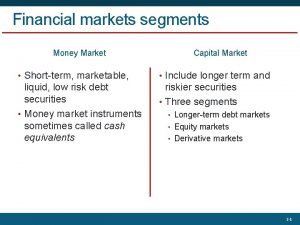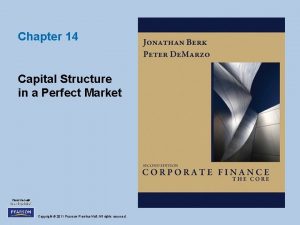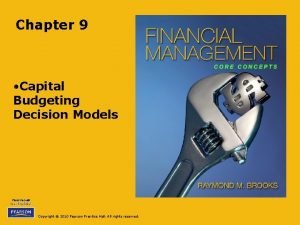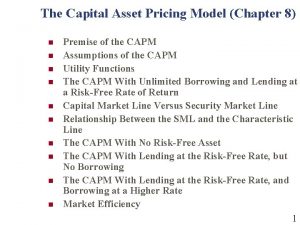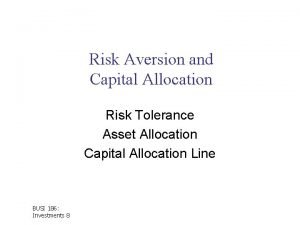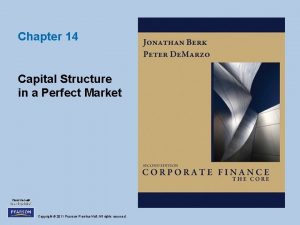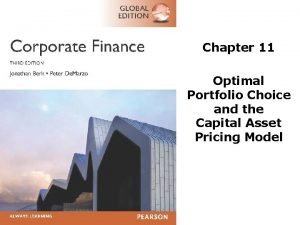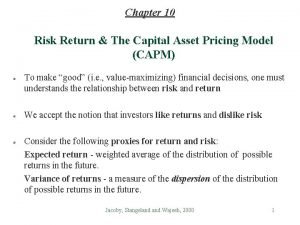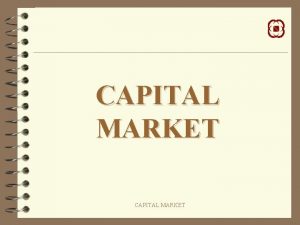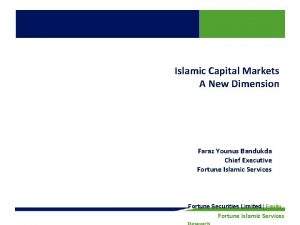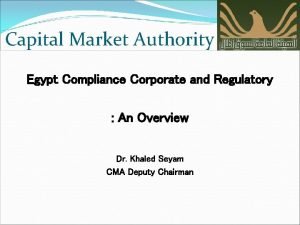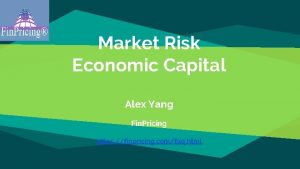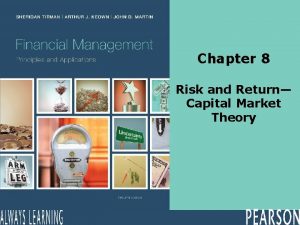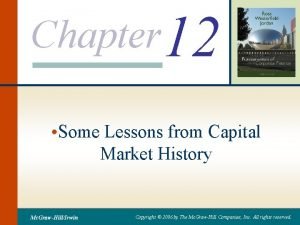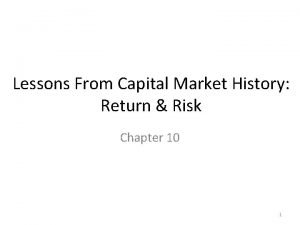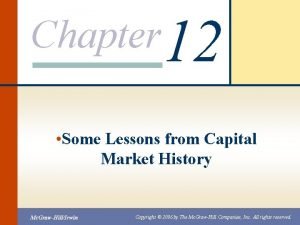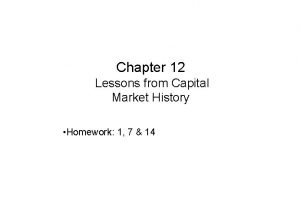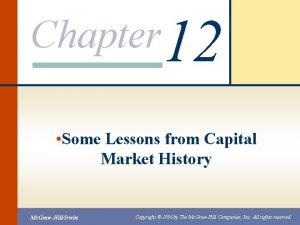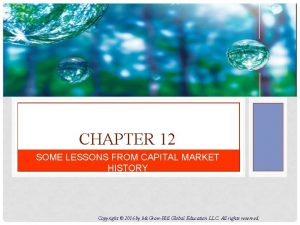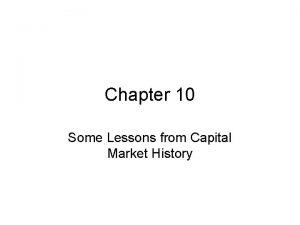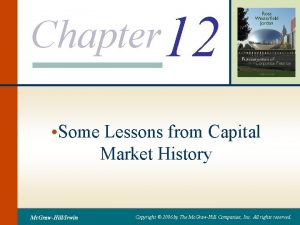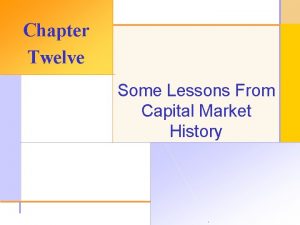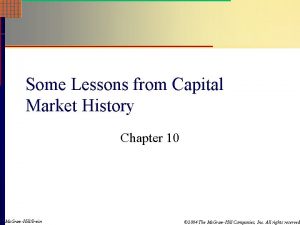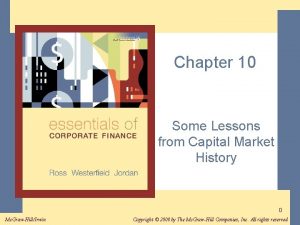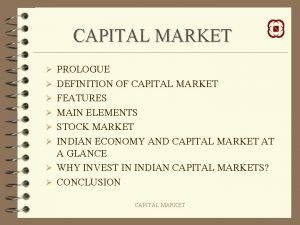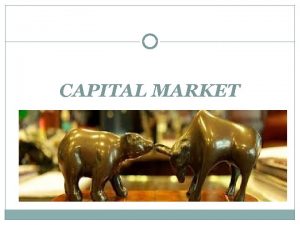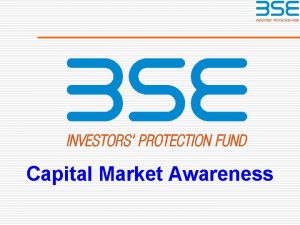Chapter 12 LESSONS FROM CAPITAL MARKET HISTORY Key

































- Slides: 33

Chapter 12 LESSONS FROM CAPITAL MARKET HISTORY

Key Concepts and Skills • Know how to calculate the return on an investment • Understand the historical returns on various types of investments • Understand the historical risks on various types of investments • Understand the implications of market efficiency Copyright © 2016 by Mc. Graw-Hill Global Education LLC. All rights reserved. 12 -2

Chapter Outline • Returns • The Historical Record • Average Returns: Lesson The First • The Variability of Returns: Lesson The Second • More about Average Returns • Capital Market Efficiency Copyright © 2016 by Mc. Graw-Hill Global Education LLC. All rights reserved. 12 -3

Risk, Return, and Financial Markets • We can examine returns in the financial markets to help us determine the appropriate returns on non-financial assets • Lessons from capital market history § There is a reward for bearing risk § The greater the potential reward, the greater the risk § This is called the risk-return trade-off Copyright © 2016 by Mc. Graw-Hill Global Education LLC. All rights reserved. 12 -4

Dollar Returns • Total dollar return = income from investment + capital gain (loss) due to change in price • Example: § You bought a bond for $950 one year ago. You have received two coupons of $30 each. You can sell the bond for $975 today. What is your total dollar return? • Income = 30 + 30 = 60 • Capital gain = 975 – 950 = 25 • Total dollar return = 60 + 25 = $85 Copyright © 2016 by Mc. Graw-Hill Global Education LLC. All rights reserved. 12 -5

Percentage Returns • It is generally more intuitive to think in terms of percentage, rather than dollar, returns • Dividend yield = income / beginning price • Capital gains yield = beginning price) • Total percentage return = gains yield (ending price – / beginning price dividend yield + capital Copyright © 2016 by Mc. Graw-Hill Global Education LLC. All rights reserved. 12 -6

Example: Calculating Returns • You bought a stock for $35, and you received dividends of $1. 25. The stock is now selling for $40. § What is your dollar return? • Dollar return = 1. 25 + (40 – 35) = $6. 25 § What is your percentage return? • Dividend yield = 1. 25 / 35 = 3. 57% • Capital gains yield = (40 – 35) / 35 = 14. 29% • Total percentage return = 3. 57 + 14. 29 = 17. 86% Copyright © 2016 by Mc. Graw-Hill Global Education LLC. All rights reserved. 12 -7

The Importance of Financial Markets • Financial markets allow companies, governments and individuals to increase their utility § Savers have the ability to invest in financial assets so that they can defer consumption and earn a return to compensate them for doing so § Borrowers have better access to the capital that is available so that they can invest in productive assets • Financial markets also provide us with information about the returns that are required for various levels of risk Copyright © 2016 by Mc. Graw-Hill Global Education LLC. All rights reserved. 12 -8

Figure 12. 4 Copyright © 2016 by Mc. Graw-Hill Global Education LLC. All rights reserved. 12 -9

Year-to-Year Total Returns Large-Company Stock Returns Long-Term Government Bond Returns U. S. Treasury Bill Returns Copyright © 2016 by Mc. Graw-Hill Global Education LLC. All rights reserved. 12 -10

Average Returns Investment Average Return Large Stocks 12. 1% Small Stocks 16. 9% Long-term Corporate Bonds 6. 3% Long-term Government Bonds 5. 9% U. S. Treasury Bills 3. 5% Inflation 3. 0% Copyright © 2016 by Mc. Graw-Hill Global Education LLC. All rights reserved. 12 -11

Risk Premiums • The “extra” return earned for taking on risk • Treasury bills are considered to be risk-free • The risk premium is the return over and above the risk-free rate Copyright © 2016 by Mc. Graw-Hill Global Education LLC. All rights reserved. 12 -12

Table 12. 3: Average Annual Returns and Risk Premiums Investment Average Return Risk Premium Large Stocks 12. 1% 8. 6% Small Stocks 16. 9% 13. 4% Long-term Corporate Bonds 6. 3% 2. 8% Long-term Government Bonds 5. 9% 2. 4% U. S. Treasury Bills 3. 5% 0. 0% Copyright © 2016 by Mc. Graw-Hill Global Education LLC. All rights reserved. 12 -13

Figure 12. 9 Copyright © 2016 by Mc. Graw-Hill Global Education LLC. All rights reserved. 12 -14

Variance and Standard Deviation • Variance and standard deviation measure the volatility of asset returns • The greater the volatility, the greater the uncertainty • Historical variance = sum of squared deviations from the mean / (number of observations – 1) • Standard deviation = square root of the variance Copyright © 2016 by Mc. Graw-Hill Global Education LLC. All rights reserved. 12 -15

Example: Variance and Standard Deviation Year Actual Return Average Return Deviation from the Mean Squared Deviation 1 . 15 . 105 . 045 . 002025 2 . 09 . 105 -. 015 . 000225 3 . 06 . 105 -. 045 . 002025 4 . 12 . 105 . 015 . 000225 Totals . 42 . 0045 Variance =. 0045 / (4 -1) =. 0015 Standard Deviation =. 03873 Copyright © 2016 by Mc. Graw-Hill Global Education LLC. All rights reserved. 12 -16

Work the Web Example • How volatile are mutual funds? • Morningstar provides information on mutual funds, including volatility • Click on the web surfer to go to the Morningstar site § Pick a fund, such as the American Funds Euro. Pacific Growth Fund (AEPGX). § Enter the ticker, press go and then click “Ratings & Risk” Copyright © 2016 by Mc. Graw-Hill Global Education LLC. All rights reserved. 12 -17

Figure 12. 10 Copyright © 2016 by Mc. Graw-Hill Global Education LLC. All rights reserved. 12 -18

Normal distribution • The normal distribution is a symmetric, bell-shaped frequency distribution § It is completely defined by its mean and standard deviation • As seen in Figure 12. 10, the returns appear to be at least roughly normally distributed Copyright © 2016 by Mc. Graw-Hill Global Education LLC. All rights reserved. 12 -19

Figure 12. 11 Copyright © 2016 by Mc. Graw-Hill Global Education LLC. All rights reserved. 12 -20

Recent market volatility • 2008 was one of the worst years for stock market investors in history § The S&P 500 plunged 37 percent § The index lost 17% in October alone • From March ‘ 09 to Feb ‘ 11, the S&P 500 doubled in value • Long-term Treasury bonds gained over 40 percent in 2008 § They lost almost 26 percent in 2009 Copyright © 2016 by Mc. Graw-Hill Global Education LLC. All rights reserved. 12 -21

Arithmetic vs. Geometric Mean • Arithmetic average – return earned in an average period over multiple periods • Geometric average – average compound return period over multiple periods • The geometric average will be less than the arithmetic average unless all the returns are equal • Which is better? § The arithmetic average is overly optimistic for long horizons § The geometric average is overly pessimistic for short horizons § So, the answer depends on the planning period under consideration • 15 – 20 years or less: use the arithmetic • 20 – 40 years or so: split the difference between them • 40 + years: use the geometric Copyright © 2016 by Mc. Graw-Hill Global Education LLC. All rights reserved. 12 -22

Example: Computing Averages • What is the arithmetic and geometric average for the following returns? § Year 1 § Year 2 § Year 3 5% -3% 12% § Arithmetic average = (5 + (– 3) + 12)/3 = 4. 67% § Geometric average = [(1+. 05)*(1 -. 03)*(1+. 12)]1/3 – 1 =. 0449 = 4. 49% Copyright © 2016 by Mc. Graw-Hill Global Education LLC. All rights reserved. 12 -23

Efficient Capital Markets • Stock prices are in equilibrium or are “fairly” priced • If this is true, then you should not be able to earn “abnormal” or “excess” returns • Efficient markets DO NOT imply that investors cannot earn a positive return in the stock market Copyright © 2016 by Mc. Graw-Hill Global Education LLC. All rights reserved. 12 -24

Figure 12. 14 Copyright © 2016 by Mc. Graw-Hill Global Education LLC. All rights reserved. 12 -25

What Makes Markets Efficient? • There are many investors out there doing research § As new information comes to market, this information is analyzed and trades are made based on this information § Therefore, prices should reflect all available public information • If investors stop researching stocks, then the market will not be efficient Copyright © 2016 by Mc. Graw-Hill Global Education LLC. All rights reserved. 12 -26

Common Misconceptions about EMH • Efficient markets do not mean that you can’t make money • They do mean that, on average, you will earn a return that is appropriate for the risk undertaken and there is not a bias in prices that can be exploited to earn excess returns • Market efficiency will not protect you from wrong choices if you do not diversify – you still don’t want to “put all your eggs in one basket” Copyright © 2016 by Mc. Graw-Hill Global Education LLC. All rights reserved. 12 -27

Strong Form Efficiency • Prices reflect all information, including public and private • If the market is strong form efficient, then investors could not earn abnormal returns regardless of the information they possessed • Empirical evidence indicates that markets are NOT strong form efficient and that insiders could earn abnormal returns Copyright © 2016 by Mc. Graw-Hill Global Education LLC. All rights reserved. 12 -28

Semistrong Form Efficiency • Prices reflect all publicly available information including trading information, annual reports, press releases, etc. • If the market is semistrong form efficient, then investors cannot earn abnormal returns by trading on public information • Implies that fundamental analysis will not lead to abnormal returns Copyright © 2016 by Mc. Graw-Hill Global Education LLC. All rights reserved. 12 -29

Weak Form Efficiency • Prices reflect all past market information such as price and volume • If the market is weak form efficient, then investors cannot earn abnormal returns by trading on market information • Implies that technical analysis will not lead to abnormal returns • Empirical evidence indicates that markets are generally weak form efficient Copyright © 2016 by Mc. Graw-Hill Global Education LLC. All rights reserved. 12 -30

Quick Quiz • Which of the investments discussed have had the highest average return and risk premium? • Which of the investments discussed have had the highest standard deviation? • What is capital market efficiency? • What are three forms of market efficiency? Copyright © 2016 by Mc. Graw-Hill Global Education LLC. All rights reserved. 12 -31

Ethics Issues • Program trading is defined as automated trading generated by computer algorithms designed to react rapidly to changes in market prices. Is it ethical for investment banking houses to operate such systems when they may generate trade activity ahead of their brokerage customers, to which they owe a fiduciary duty? • Suppose that you are an employee of a printing firm that was hired to proofread proxies that contained unannounced tender offers (and unnamed targets). Should you trade on this information, and would it be considered illegal? Copyright © 2016 by Mc. Graw-Hill Global Education LLC. All rights reserved. 12 -32

Comprehensive Problem • Your stock investments return 8%, 12%, and -4% in consecutive years. What is the geometric return? • What is the sample standard deviation of the above returns? • Using the standard deviation and mean that you just calculated, and assuming a normal probability distribution, what is the probability of losing 3% or more? Copyright © 2016 by Mc. Graw-Hill Global Education LLC. All rights reserved. 12 -33
 Capital allocation line vs capital market line
Capital allocation line vs capital market line Money market
Money market Capital market and money market
Capital market and money market Hypothetical market structure
Hypothetical market structure Segmentation levels
Segmentation levels Robert hook cell theory
Robert hook cell theory Capital structure in a perfect market
Capital structure in a perfect market Tone diction imagery
Tone diction imagery Voice lessons diction answer key
Voice lessons diction answer key Npv profiles
Npv profiles Key resources examples
Key resources examples Business model canvas tripadvisor
Business model canvas tripadvisor Net working capital refers to which of the following
Net working capital refers to which of the following Source of capital reserve
Source of capital reserve Multinational cost of capital and capital structure
Multinational cost of capital and capital structure Difference between capital reserve and reserve capital
Difference between capital reserve and reserve capital Regulatory capital vs economic capital
Regulatory capital vs economic capital Regulatory capital vs economic capital
Regulatory capital vs economic capital Variable capital examples
Variable capital examples Multinational cost of capital and capital structure
Multinational cost of capital and capital structure Chapter 6 quiz 1 lessons 6-1 and 6-2 answers
Chapter 6 quiz 1 lessons 6-1 and 6-2 answers American federal floral design history
American federal floral design history Capital market line
Capital market line Dominant capital allocation line
Dominant capital allocation line Homemade leverage upsc
Homemade leverage upsc Capital market line
Capital market line Capital market line
Capital market line Capital market structure in india
Capital market structure in india Capital market development authority
Capital market development authority Importance of capital market
Importance of capital market The following are advantages of the sml approach
The following are advantages of the sml approach Capital market authority egypt
Capital market authority egypt Market risk economic capital
Market risk economic capital Capital market theory
Capital market theory

